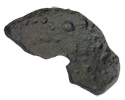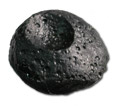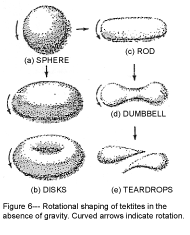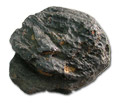|
From "Rocks and minerals from outer space part II: tektites" by K. Nassau, Ph.D. Lapidary Journal May 1972
Origin of Tektites
The nature and origin of tektites can best be outlined by listing the following fairly well established facts and deductions:
1. Tektites are glassy objects of chemical and isotopic composition fairly normal to earth rocks, and are therefore believed to originate from earth material soil and/or rock;
2. Tektites are remarkably free of water and other volatile components. This is attributed to melting in a very low pressure environment and is confirmed by a low Fe3 + to Fe2 ratio characteristic of melting in the absence of oxygen. Such an environment occurs near the earth only in outer space;
3. Examination of the cosmic ray irradiation characteristics shows that tektites have not been in outer space (above the earth's atmosphere) too long, e.g., no further than the moon'ís distance for a reasonable velocity;
4. Tektites were molten in outer space, and characteristic shapes (spheres, disks, rods, dumbbells, teardrops) result from solidification in free fall in outer space (the primary phase forms);
5. Tektites fell through the atmosphere resulting at time in considerable modification of their shape (secondary phase). These shapes may have been further modified on impact at the earth's surface, and by subsequent etching by solutions at the surface i.e., weathering (tertiary phase).
 6. Two of the four tektite areas can be associated with large meteorite craters where the age of impact and the composition of ground in the impact area correspond approximately with the age and composition of the tektites: The Ries Crater at Nordlingen in Germany related to the moldavites found 260 to 400 kilometers away and Lake Bosumtwi, another impact crater in Ghana related to the Ivory Coast tektites found 300 kilometers away; 6. Two of the four tektite areas can be associated with large meteorite craters where the age of impact and the composition of ground in the impact area correspond approximately with the age and composition of the tektites: The Ries Crater at Nordlingen in Germany related to the moldavites found 260 to 400 kilometers away and Lake Bosumtwi, another impact crater in Ghana related to the Ivory Coast tektites found 300 kilometers away;
7. In some Pacific areas, as well as in Texas, tektites of the usual shapes (spheres, disks, rods, dumbbells, teardrops) are associated with otherwise identical material which solidified after landing on the earth as shown by trapped soil, pebbles, etc., the so-called Muong Nong type tektites, named after the type locality in Laos;
8. Tektites are sometimes found to contain traces of nickel and also metallic spherules, confirming the involvement of meteorites in their formation.
 9. From these data one can formulate the following sequence: A meteorite (or comet or asteroid) hits the earth's surface, producing melting of the local soil and rock and imparting sufficient velocity to splash part of the molten mass into space well above the earth's atmosphere. Water is lost and some of the Fe2O3 is reduced to FeO. Solidification occurs during free fall in outer space. Re-entry into the atmosphere and impact on the earth's surface occurs later with modification of the shape as described below. Since the molten mass follows a definite orbit, the fall will cover a limited area. 9. From these data one can formulate the following sequence: A meteorite (or comet or asteroid) hits the earth's surface, producing melting of the local soil and rock and imparting sufficient velocity to splash part of the molten mass into space well above the earth's atmosphere. Water is lost and some of the Fe2O3 is reduced to FeO. Solidification occurs during free fall in outer space. Re-entry into the atmosphere and impact on the earth's surface occurs later with modification of the shape as described below. Since the molten mass follows a definite orbit, the fall will cover a limited area.
The only other mechanism which could account for tektites would involve very violent volcanic action. It is difficult to see how a terrestrial eruption could be violent enough to elevate material above the earth's atmosphere. A volcanic eruption on the moon, with its lower gravitational pull, might seem more plausible, but since the isotopic ratios of tektites are the same as those of earth rock and quite different from the moon rock examined so far, this would again imply a highly unlikely situation.
Origin of the Shape of Tektites
 A molten mass suspended without rotation in free fall in outer space, i.e., in the absence of gravity, assumes a spherical shape and will remain so on solidification. A small amount of rotation will produce flattening of the sphere toward disk shapes. Rotation on certain axes with a nonspherical mass, however, will lead towards the sequence rod -> dumbbell -> two teardrops.
Friction fusion during re-entry into the atmosphere produces surface melting, resulting in pitting and fine flow lines. The flow lines may be intensified or destroyed by subsequent weathering. The molten material may be blown off, or it may partially re-solidify on the tektite, resulting in the rare flanged disk type found among australites.
 In the case of the Muong Nong type it would appear that the size of the falling tektite, its temperature, and the impact velocity on the earth were such that the tektite either did not solidify in space, or re-melted on impact, so that final solidification took place after impact. In this way pebbles and local soil can become partly incorporated into the tektite. Nevertheless other characteristics, such as composition and low water content, remain the same as those of ordinary tektites found in the vicinity. In the case of the Muong Nong type it would appear that the size of the falling tektite, its temperature, and the impact velocity on the earth were such that the tektite either did not solidify in space, or re-melted on impact, so that final solidification took place after impact. In this way pebbles and local soil can become partly incorporated into the tektite. Nevertheless other characteristics, such as composition and low water content, remain the same as those of ordinary tektites found in the vicinity.
| 
